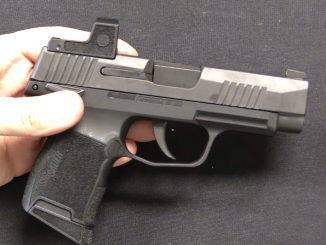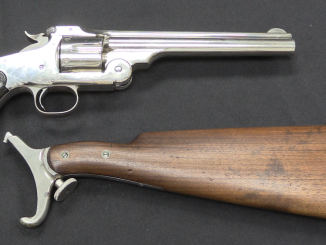The US military adopted the Model 1903 Springfield rifle in 1903, replacing the short-lived Krag-Jorgenson rifle. However, the 1903 would undergo some pretty substantial changes in 1905 and 1906 before becoming the rifle we recognize today. The piece in todays video is an original Springfield produced in 1904, before any of these changes took place.
The most notable difference is the use of the rod bayonet. When the 1903 was in development, the Ordnance Department opined that the bayonet was largely obsolete, and that it was unnecessary to encumber soldiers with a long blade hanging from the belt. Instead, the new rifle would have a retractable spike bayonet that could double as cleaning rod and would be stored in the rifle stock, unobtrusive to the soldier. This ended in 1905 with a critical letter from Theodore Roosevelt (who was Secretary of War at the time). As the rod bayonet was replaced with a traditional blade bayonet, the cartridge would also be improved to a new style spitzer projectile at higher velocity, and the rifles’ stocks, hand guards, and sights redesigned.
In this video I also discuss two often misunderstood elements of the Springfield’s history: heat treating and patent royalties. Are low serial number 1903 Springfields safe to shoot, and why or why not? And did the US government actually pay royalties to Germany for copying Mauser elements in the 1903?




I enjoyed the video and the length wasn’t an issue for me.
Roosevelt was right. Which is more useful in the field, an easily bent rod or a sturdy versatile survival knife which doubles as a bayonet? The soon-to-be president Teddy actually BENT THE ROD BAYONET IN HALF WITH HIS BARE HANDS!!!!
“BENT THE ROD BAYONET IN HALF WITH HIS BARE HANDS!!!!”
Conclusion is that any new technology need extensive testing before introducing.
See MacAdam Shield-Shovel as example of not properly tested equipment.
Others also tested various alternative bayonets, for example Mondragón rifle can be equipped with spade bayonet.
The same problem surfaced in the American Civil War.
The epee’ pattern bayonet standard on the Springfield and Enfield rifle-muskets had a triangular cross-section blade and a needle-sharp point, but no cutting edges.
While this may have made it a more effective thrusting weapon, it was utterly useless for the variety of camp chores for which a strong, sturdy, sharp knife is indispensable.
Letters home and articles written as advice to new recruits stated that every volunteer should provide himself with a good sheath knife with at least a 6″ blade, a jackknife with both “big” and “little” blades, and a camper’s type knife/fork/spoon combination. Leaving the bayonet for being stuck on the end of the rifle-musket when commanded to do so.
A letter one of my ancestors who served with the Ohio Volunteers (infantry) stated that the issue bayonet had exactly three uses in camp; as a roasting spit (stuck on a wooden stick, not the rifle), a candle holder (point stuck in ground or a stump, candle stuck in muzzle attachment iron), or a tent-peg (self-explanatory).
BTW, bayonet “kills” were extremely rare in the Civil War. Union medical corps recorded treating less than 100 bayonet wounds inflicted in combat during the course of the entire war. There were however many such wounds in training, mostly self-inflicted, usually to the hands when learning to fix the bayonet.
The instep of the foot was another popular “target”. Usually due to one of the rotational moves of the “French style” of bayonet drill popular with Zouave regiments. As one veteran wrote;
The fact is that the bayonet’s day was pretty much over by the mid-19th Century. Rapid volley fire of infantry musketry plus artillery generally decided the issue before it got down to bayonet range.
In WW1, bayonets were used in trench warfare mainly as short swords, in the hand, for close-in fighting, not on the muzzle of the rifle. and the French soldier’s affection for “Rosalie'” not withstanding, a knife-type bayonet that could both cut and thrust was a far more effective weapon than an epee’ type that could only thrust. The 18″ bladed bayonet for the U.S. M1917 Enfield .30-06 rifle being a case in point, if you’ll pardon the expression.
The bayonet has lost almost all usefulness on the end of the rifle today. Modern carbine length arms like the M4 or bullpups like the L85 are simply too short to be practical bayonet “handles”.
A riot-type shotgun like the Mossberg 590 is about the last good bayonet mount there is.
Thrust. Twist. Withdraw. Butt stroke to the head.
And the occasional block.
That’s really all there is to “bayonet fighting”.
cheers
eon
Eon,
Just an logical observation…
The oft-quoted “statistic” on how few bayonet “kills” were recorded has a pretty obvious fatal flaw to it.
Neither the Union Medical Corps nor any other medical arm of any military organization ever treated bayonet “kills.”
The “kills” are buried, not treated.
OOPS. I should have said “wounds” not “kills”.
*headdesk*
But Medical kept track of death statistics, too, and found that wounds or deaths due to edged weapons of any kind (bayonet, saber, whatever) were rare.
The fact is that firearms technology of the time, as primitive as it was by modern standards, meant that it was unlikely anyone would get close enough to resort to “cold steel” on a battlefield.
Here’s what Jack Coggins had to say on the subject in Arms and Equipment of the Civil War (Doubleday, 1962).
Re the bayonet;
As for the cavalry’s use of the arme blanche, Coggins had this interesting quote;
Stonewall Jackson drew his saber so rarely that after his death it was found to be rusted tight in its metal scabbard.
While some cavalry units swore by the saber, their actual use seemed to be when counter-charging against other cavalry units with a similar mindset.
More often, cavalry on both sides fought more as mounted infantry, using carbines and dismounting to form skirmish lines while every tenth man held the horses in the rear, as Buford’s unit did on the first day of Gettysburg during the street fight in the town itself.
Speaking of Gettysburg, Joshua Chamberlain and the 20th Maine’s “bayonet charge” down Little Round Top was at a walk, and was a desperation move because they were almost completely out of ammunition.
And even then they never closed; the Confederates, their morale broken after a few hours of being hammered by the volunteers’ musketry, broke and either ran or surrendered.
Those recruits who bought or were given sheath knives or “Bowie” knives to take with them had some good arguments on their side.
Those who also tucked a revolver, even a small one, inside their belts in case things got “up close and personal” probably had an even better one.
cheers
eon
I owned a low number RIA which I never shot. However I have never totally understood why the heat treatment issue only applies to low numbered 03s and not to Krags also. I am aware that some of problems lay in ammunition quality, but not all. I have also heard that the problem was also related to new inexperienced workers hired during WWI, however if this was the only cause than the issue should not apply to rifles produced before the war. If the issue is also due the sunny vs. cloudy day conditions than it would seem Krags would be affected also in spite of the differences between the .30/40 rimmed case and the .30-06 rimless case and the different 03 rifle chamber.
Hatcher’s Notebook, Second Edition, 1957;
http://sin.thecthulhu.com/library/weapons/hatchers_notebook.pdf
Chapters 8 and 9 cover the history of the M1903 “heat treatment” issue, including a complete list of which serial number ranges at which gunmakers received which heat treatment, and the effects thereof.
Hatcher, at that time a major, was in charge of the program. The rest of the book is equally useful, as well as just a fascinating read for anyone interested in firearms.
cheers
eon
The Krag ammunition was supposed to be kept under 42,000 PSI wile the ’03 was 50,000 PSI — about 20% higher.
The Krag used a rimmed cartridge while the ’03 used a rimless cartridge and most rimless cartridge rifles of that era, the ’03 included, left a little of the base of the cartridge unsupported. As Ian said that it was rupturing brass that caused the issue, the Krag, with very little of the cartridge unsupported, would have had an advantage over the ’03.
The original ’03 used a proprietary steel and had a heat treat cycle that had a 25 degree window. Have not been able to find any information on the Krag steel or heat treating, but would wager that it was different. It (the Krag) may have been of an alloy and heat treat cycle that was more forgiving of error.
As an aside, 50 years later when the FAL and M-14 were in trials the ordinance board thought that a better suitability of the M-14 for bayonet fighting was a point in its favor. The bayonet issue was also a black mark against the Johnson rifle in the early ’40’s.
In 1905 William Howard Taft was Secretary of War. Perhaps President Theodore Roosevelt sent him the letter mentioned.
An interesting rifle, and while the cleaning rod bayonet was impractical, so were other bayonet ideas over the years.
I misspoke – TR sent that letter *to* the Secretary of War, while he was President.
A bayonet that doubles as a cleaning rod. Besides being easy to bend using it to stab with I also wonder how many soldiers stabbed themselves trying to clean their rifle?
Ian- The M1903 Springfield rod-bayonet is ONLY a bayonet. It is not a dual purpose cleaning rod and/or bayonet, as was the case with the earlier (M1833, 1880, M1882, M1884 or M1888) rod bayonet longarms.
The M1903 bayonet diameter is larger than the bore diameter, so it is IMPOSSIBLE to even attempt to use it as a cleaning rod.
Easy mistake to make, especially when you are being careful with other people’s guns and reluctant to fiddle too much with them.
Otherwise, another excellent, well researched, informative and entertaining video.
Crap – thanks for pointing that out!
Thanks for pointing out the real history of the patent issue–as opposed to repeating what “everybody knows.”
One of the factors overlooked by those wondering why there were so few actual bayonet hits on a battlefield is the dynamics of two opponents armed with a “pole” with a blade at the far end. That pole is not held in the center of it’s length, but closer to the butt end.
The object is to first get inside the “poking” radius of that blade, and this is done by using your pole to block and sweep it to the side so you can step forward. Notice that this also puts your opponent inside your own poking radius. The next step is to apply the forend and then the buttstock to your opponent, until they fall down and cease opposing you.
At this point, to employ the bayonet, you will have to step BACKWARDS probably twice to bring it to bear. This is not optimum, for a number of reasons. One would normally continue forward, or perhaps toward the side, depending on how your fellow soldiers are faring.
Also, stabbing a body that is already on the ground, with a blade long enough to protrude out the far side, brings hazards into play. That body is against a solid object, and can’t pull away, so if done with vigor, it WILL exit. You may not be able to extract it from the body, depending on what it struck in or on the ground.
Could the use of the 220gr. R.N. round have been a cost savings device, since the Krag used the same round? How similiar (aside from dia.) are the 1903 rod bayonet and the 1888?